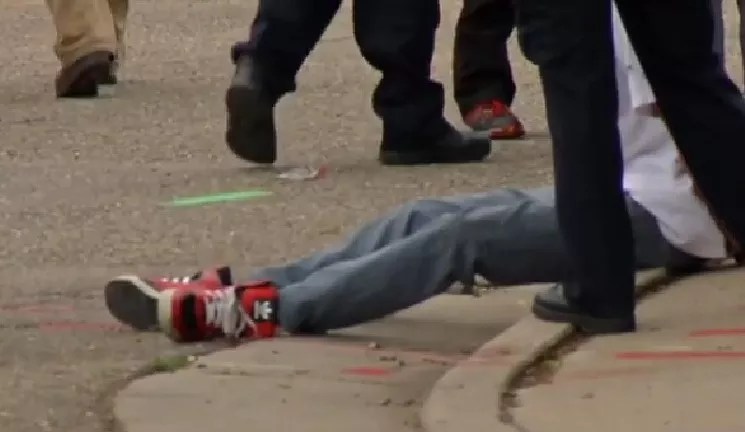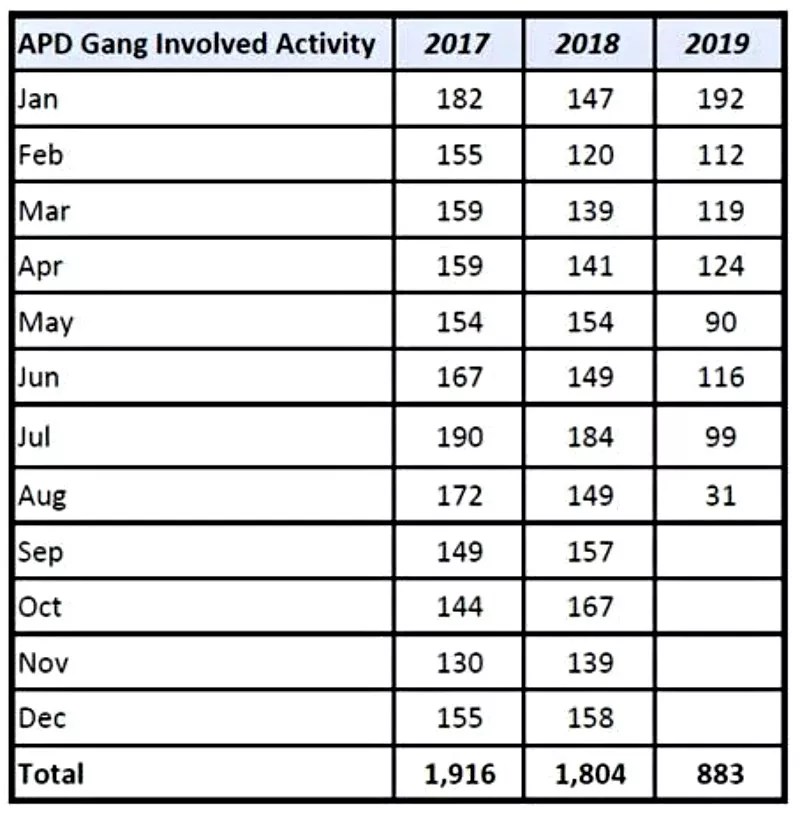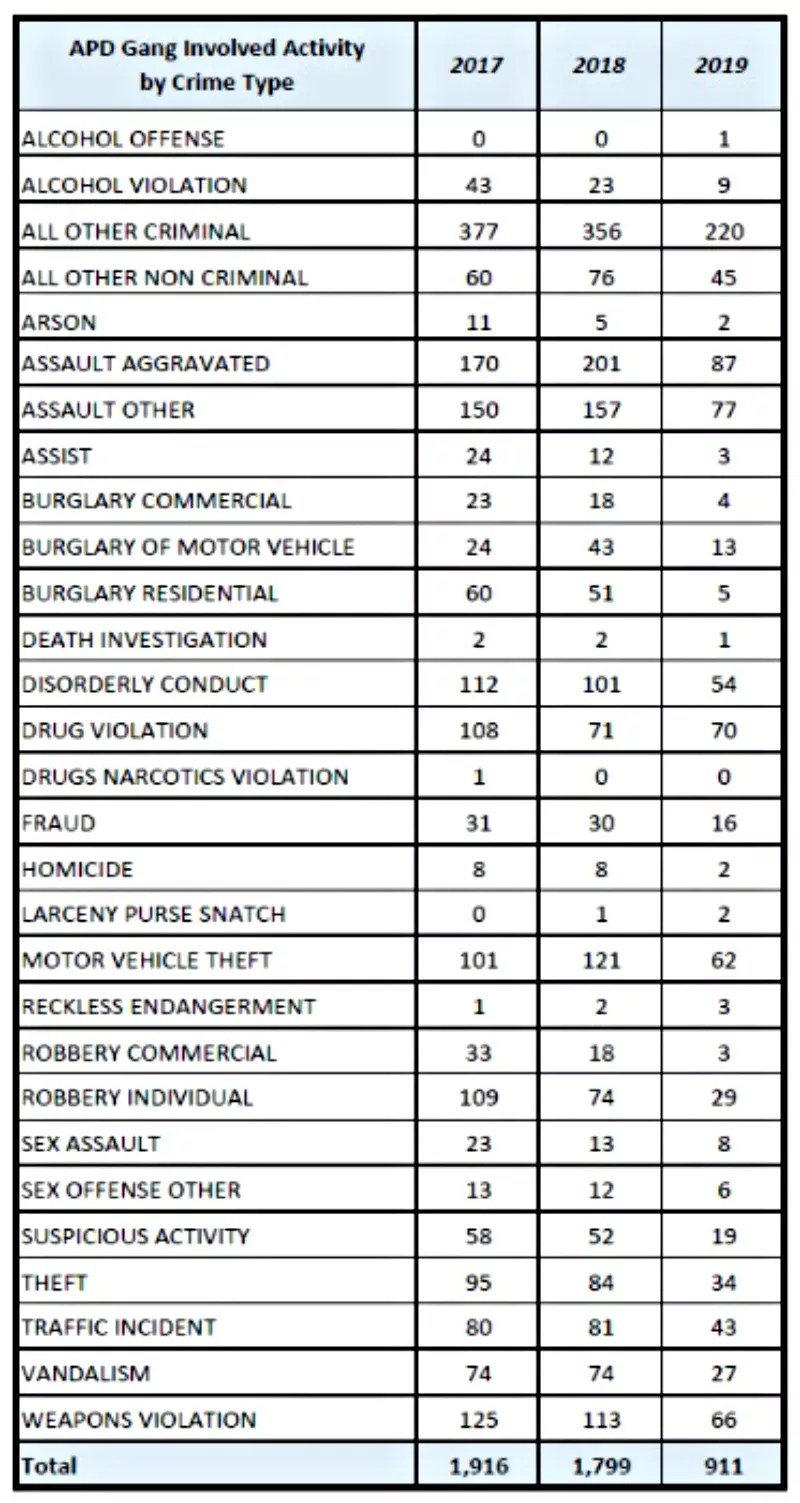
Denver7 file photo

Audio By Carbonatix
In a recent article about gang recruiting in gentrifying neighborhoods near RiNo, Denver Police Department Division Chief Jeff Martinez, the District 1 commander, cited intel that some bangers who’d previously operated in the Mile High City had relocated to Aurora.
Now, information from Sergeant Kevin Rossi, who heads the gang intervention unit for the Aurora Police Department, lends further credence to these reports. While data shared below shows that gang-related incidents in Aurora have been falling, the number of members is on the rise. As of September 2018, Rossi reveals, the APD counted approximately 1,100 gang members as city residents. By the end of August, that total had grown to 1,300.
“There are at least 200 more gang members in our city than we were previously aware of,” Rossi says.
The reasons behind this migration, which has increased Aurora’s suspected gang population by more than 18 percent in a year, are unclear. But there’s no question that Denver neighborhoods that have traditionally been the setting for gang activity (including Cole and Whittier, near the RiNo Art District) have undergone massive changes over the past several years, with gentrification displacing locals who can no longer afford to live in their longtime homes. Rent costs in Denver may have moderated of late, especially in comparison with mid-decade peaks, but plenty of neighborhoods in Aurora remain much less expensive.
At the same time, Rossi reveals, “we’ve seen an influx in some gangs that we haven’t seen in Aurora. These are older Denver gangs, like the East Side Crips. Their location was west of Colorado Boulevard, around the Curtis Park area. I know there’s been development around there that’s moved out a lot of older residents because of high-dollar housing. We’ve also seen a lot of Park Hill Bloods and CMG Bloods – that’s the Crenshaw Mafia Gang Bloods. We’ve had quite a few bloods in Aurora, but it’s unusual to see East Side Crips from various different sets here, and we’ve definitely had contact with quite a few. I’m not sure if that has any direct correlation with housing or not, but historically, they stay away from Aurora.”
The Aurora Police gang unit keeps track of crimes suspected of having been committed by individuals with gang affiliations, and the numbers have been falling steadily over the past three years. Here’s a chart depicting the number of activities suspected gang-involvement incidents from 2017 through August 2019:

Aurora Police Department
The Aurora Police Department has also broken down figures in terms of specific offenses, and they show declines in the vast majority of crimes, including the most serious.
For instance, there were two homicides thought to have involved gang members in 2019 through last month, as compared to eight each of the previous two years. Likewise, robberies of individuals have dipped substantially (29 through August 2019 versus 109 in 2017 and 74 last year), and sex assaults have gone from 23 in 2017 and thirteen in 2018 to eight as of September 1. Only two categories of crime have seen increases in 2019: larceny purse snatch (two, up from one in 2018) and reckless endangerment (three, up from two last year).
See the stats here:

Aurora Police Department
Rossi is happy with the trend reflected by these charts, but, he says, “I do want to forewarn you that when we’re talking about gang-involved activity or crimes, it’s very difficult to put numbers on them, because we don’t always know if it’s a gang-related crime that’s taking place. For example, when a patrol officer goes out and takes a report, he or she isn’t always aware if somebody is a gang member or not. We’re trying to fix that, trying to collect better statistical data, and we’ve changed some of the ways we’ve collected it – but our system hasn’t caught up yet.”
Resources are also an issue: Aurora’s gang unit includes just six officers for whom keeping tabs on 1,300 gang members is a Herculean task. Nonetheless, Rossi points out, “We’ve really focused on getting out there and contacting gang members in our city – and that may be another one of the reasons we’ve seen an increase.”
This tactic “serves multiple purposes,” Rossi goes on. “It lets our patrol guys know who’s in our city, and it lets gang members know we’re out there and watching for them. They realize that we’re going to be monitoring what’s happening in our city and we’re going to combat it and aggressively prosecute it. We’re not going to tolerate it, and that message gets sent out when we make contacts. We’ll hear gang members say things like, ‘The Aurora gang unit is out. Stay away.’ I think that has a direct correlation with the amount of crime occurring in our city, and it also helps officer safety. If we’re aware of all the gang members and their activities, they know when they go on a call or make a traffic stop that they could be stepping into a potentially dangerous situation.”
He emphasizes that “this isn’t a profiling kind of thing, but more about targeting areas. For example, we may have a hotel within the city where we’ve had a big influx of complaints from folks in the community about drug transactions taking place or gang members hanging out. So we’ll go and look to see if there’s any activity indicative of gang membership and talk to people individually to see what we can find out. When we do that, I believe that because we’re in those areas and we’re more visible, that brings our gang crime down. And it helps us get ahead of problems that might arise – disputes that might happen between different gangs.”
The early intervention theme also connects to the department’s work with Aurora’s Gang Reduction Impact Program, shorthanded as A-GRIP. “It’s an organization that’s really proactive,” Rossi maintains. “Their mission is to get kids out of gangs, so if there are any early signs, they try to provide help and assistance to the kid and the family. And we also provide training to all of our school resource officers. We work extremely closely with the school districts; we’ve got those guys on speed dial. The gang unit will also come in and talk to kids and reach out to parents. I’ll have parents call and say, ‘This is what I’m seeing. What do you recommend? Is this something I should be worrying about?’ I get those calls daily.”
Such conversations may well happen more frequently given the arrival of more gang members – and Rossi says they’re not congregating in a single area. “In Aurora, most gangs are all over. They’re not super-territorial, and it’s not uncommon to have an apartment complex where rival gang members are residing among each other, which can be challenging. When they’re paying rent every month, they typically try to stay away from each other, but if they’re staying in motels, conflicts can absolutely happen.”
Differing affiliations among relatives only adds to the complications.
The gang unit “recently contacted a pretty high-ranking member of a Crips set that was formed in Montbello, but it has a lot of overflow into Aurora,” Rossi explains. “He’s got several brothers, and him and his older brothers are part of the Crips, but all of his younger brothers are CMG Bloods. That’s not uncommon to see. We can have brothers with the same family, with the same mom and dad, in different sets, and cousins, too. It’s relatively frequent in this area.”
The idea that gangs and gang members would be open to relocating is part of their DNA, Rossi believes. “Let’s face it: Most of the gangs in this area were brought here straight from Los Angeles. Members in L.A. moved to Colorado, and once they got here, they set up shop. Michael Asberry, who started the Tre Tre Crips, one of the prevalent east-side gang sets, was from L.A.: He spent summers there but was a gang member here, and he brought the set here in the ’80s – and in 2019, there are hundreds of local members just in that gang alone. So it’s an issue, and I would say a good percentage of the violent crime in Aurora is committed by gang members.”